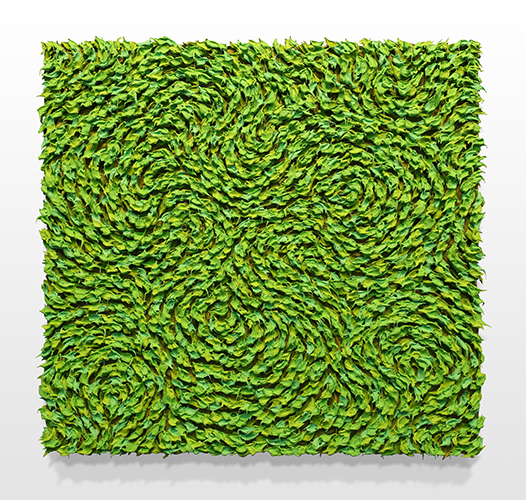
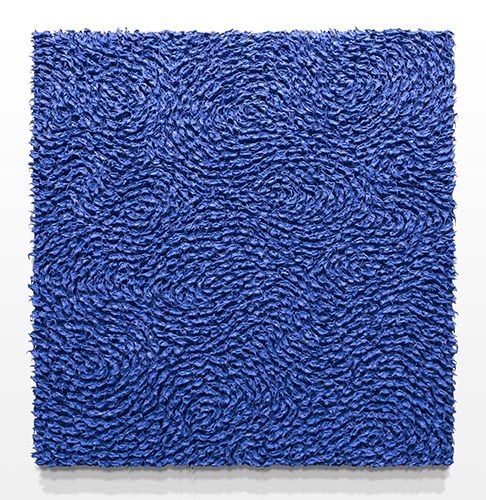
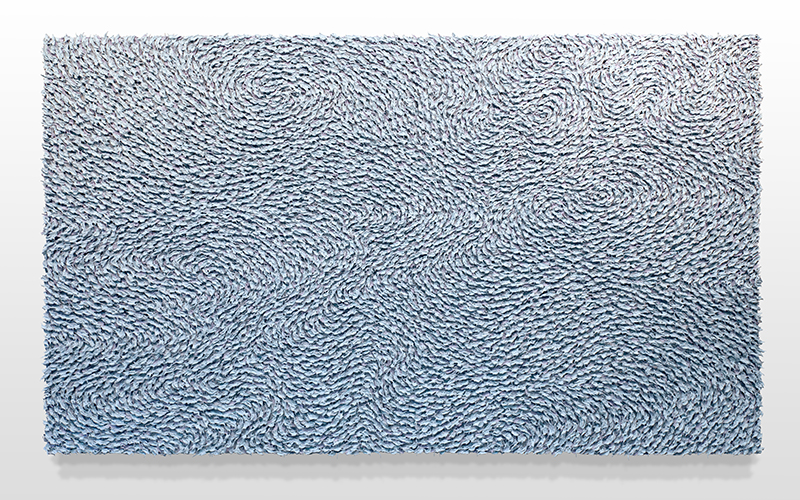
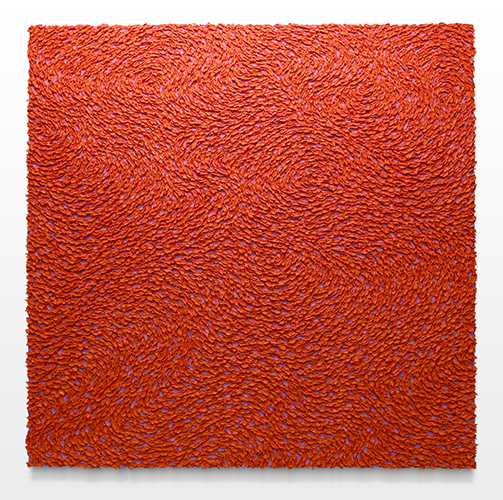
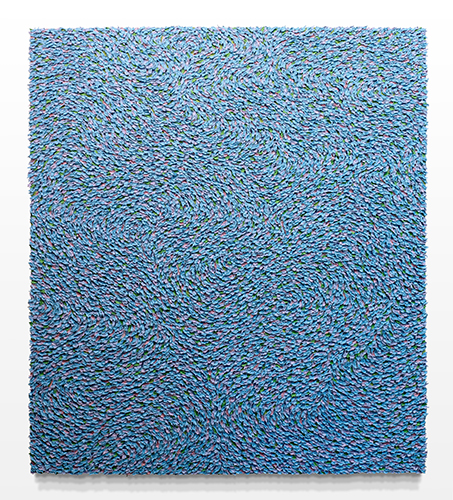
7,711 26in x 25 oil on canvas 2019
20,180 41in x 71 oil on canvas 2019
22,579 48in x 46 oil on canvas 2020
| Artistic and Academic Curriculum Vitae | |
| 1966 | born in Bayside, NY |
| 2008 | Ph.D., New York University, Dept. of Hebrew and Judaic Studies |
| 2000 | M.A., New York University, Dept. of Religious Studies |
| 1998 | M.A., Pratt Institute, Dept. of Art History |
| 1998 | M.A., Pratt Institute, Dept. of Fine Arts |
| 1990 | B.A., Pratt Institute, Dept. of Fine Arts |
| 1984-1986 | United States Military Academy |
| lives and works in New York City and Shamong, New Jersey | |
Museum Collections
Karl Ernst Osthaus-Museum Hagen
Portland Art Museum, Portland, Oregon.
Museum Für Konkrete Kunst, Ingolstadt, Germany.
| Solo Exhibitions | |
| 2020 | Permutation as Refinement, Cris Worley Fine Arts, Dallas, TX
|
| 2019 | Efflux, Brian Gross Fine Art, San Francisco, CA
|
Instantiations, Philip Slein Gallery, St. Louis, MO
|
|
| 2018 | Small Gestures, and the Fullness of Fields, Cris Worley Fine Arts, Dallas, TX
|
| 2017 | Groundwork, Galerie Peithner-Lichtenfels, Vienna, Austria
|
Totalizations, Marcia Wood Gallery, Atlanta, GA
|
|
| 2016 | Cumulus, Brian Gross Fine Art, San Francisco, CA
|
Monochrome Paintings, Philip Slein Gallery, St. Louis, MO
|
|
| 2014 | Far Closer, Margaret Thatcher Projects, New York
|
| 2013 | Peter Blake Gallery, Laguna Beach, CA
|
Openings, Marcia Wood Gallery, Atlanta, GA
|
|
| 2012 | It’s Time, Margaret Thatcher Projects, New York
|
Still Without Cessation, Brian Gross Fine Art, San Francisco, CA
|
|
| 2011 | Galerie Renate Bender, Munich, Germany |
| Ermanno Tedeschi Gallery, Rome, Italy | |
| 2010 | The Number Escapes Me, Marcia Wood Gallery, Atlanta, GA
|
| 2009 | On and On: Inquiries into Indeterminacy, Margaret Thatcher Projects, New York |
| Workings, Brian Gross Fine Art, San Francisco, CA | |
| Ermanno Tedeschi Gallery, Turin and Milan, Italy | |
| 2008 | Pathways to Presence, Galerie Renate Bender, Munich, Germany |
| 2008 | Never. Ever., Marcia Wood Gallery, Atlanta, GA |
| 2007 | dematerializations / interstices / permutations, Brian Gross Fine Art, San Francisco, CA |
| 2007 | Activity, Margaret Thatcher Projects, New York |
| 2006 | Recent Paintings, Galerie Renate Bender, Munich, Germany |
| 2006 | Innumerable Naught Nary, Marcia Wood Gallery, Atlanta, GA |
| 2005 | Amassing Color, Margaret Thatcher Projects, New York |
| Marking Time, Brian Gross Fine Art, San Francisco, CA | |
| 2004 | Marcia Wood Gallery, Atlanta, GA |
| 2003 | 435,546 Marks, Margaret Thatcher Projects, New York, NY |
| Group Exhibitions | |
| 2019 | Summer Highlights, Cris Worley Fine Art, Dallas, TX
|
Weiss, Galerie Renate Bender, Munich, Germany
|
|
Weiss, Galerie Haas, Ingolstadt, Germany
|
|
| 2018 | Room for Play, Heather Gaudio Fine Art, New Canaan, CT
|
Improvisations and Premeditations, Philip Slein Gallery, St. Louis, MO
|
|
Emerging to Established, Krause Gallery, New York
|
|
| 2017 | The Spirit of Abstraction, Philip Slein Gallery, St. Louis, MO
|
Opening Scene, Marcia Wood Gallery, Atlanta, GA
|
|
Black & White, QuadrART, Dornbirn, Austria
|
|
| 2016 | Big Art/Small Scale, Philip Slein Gallery, St. Louis, MO
|
50 Shades of Red, Galerie Renate Bender, Munich, Germany
|
|
Gallery Artists, Peter Blake Gallery, Laguna Beach, CA
|
|
| 2015 | Summer Group Show, Peter Blake Gallery, Laguna Beach, CA
|
Hot Spots, Margaret Thatcher Projects, New York
|
|
Black and White, Galerie Renate Bender, Munich, Germany
|
|
Schwarz auf Weiss, Museum Für Konkrete Kunst, Ingolstadt, Germany
|
|
Mostly Monochrome, Galerie Renate Bender, Munich, Germany
|
|
| 2014 | Pouring it On, The Herter Gallery, University of Massachusetts at Amherst
|
Summer Formal, Peter Blake Gallery, Laguna Beach, CA
|
|
E Artists, Ermanno Tedeschi Gallery, Tel Aviv, Israel
|
|
Faszination FARBE, Kunsthaus Furstenfeldbruck, Germany
|
|
| 2013 | New Year 2013, Margaret Thatcher Projects, New York
|
Living Grey, Mies van der Rohe House, Berlin, Germany
|
|
Excavating Layers, Richmond Art Center, Richmond, CA
|
|
The Nature of Abstraction, Peter Blake Gallery, Laguna Beach, CA
|
|
| 2012 | Ermanno Tedeschi Gallery, Turin, Italy
|
Peter Blake Gallery, Laguna Beach, CA
|
|
| 2011 | World, Ermanno Tedeschi Gallery, Tel Aviv, Israel
|
| 2010 | Elevazioni e Permutazioni, PaRDeS, Mirano, Italy
|
Gesture, Brian Gross Fine Art, San Francisco, CA
|
|
Monochrome II, Galerie Renate Bender, Munich, Germany
|
|
| 2009 | Pure Paint, Henry Gregg Gallery, Brooklyn, NY
|
Common Ground: Color, Charlotte Jackson Fine Art, Santa Fe, NM
|
|
| Pure Paint, Henry Gregg Gallery, Brooklyn, NY Common Ground: Color, Charlotte Jackson Fine Art, Santa Fe, NM | |
| 2008 | Material Color, Hunterdon County Art Museum, Clinton, NJ |
| This Just In, Marcia Wood Gallery, Atlanta, GA | |
| The Fascination of the Color Red, Galerie Renate Bender, Munich, Germany | |
| 2007 | Luxe, Marcia Wood Gallery, Atlanta, GA |
| …das viereckige rot?, Galerie Albert Baumgarten, Freiburg, Germany | |
| Farbe, Galerie Huebner, Hamburg, Germany | |
| Surface Impressions, Islip Art Museum, Islip, NY | |
| 2006 | Don’t Touch, Renate Bender Gallery, Munich |
| Blue!, Karl Ernst Osthaus-Museum Hagen, Germany | |
| 2005 | Summer Sensation, Margaret Thatcher Projects, New York, NY |
| About Paint, Westport Arts Center, Westport, CT | |
| Living Gray, Karl-Ernst Osthaus-Musuem, Hagen, Germany | |
| 2004 | Exhibition for World Peace, Gallery Bijitsu-Sekai, Tokyo, Japan |
| ArtHouse, Margaret Thatcher Projects, New York, NY | |
| Painting as Process: Re-evaluating Painting, La Salle SIA College of the Arts, Singapore | |
| Die Farbe hat Mich II, Karl Ernst Osthaus-Museum, Hagen, Germany | |
| Group Exhibtion, M% Gallery, Cleveland, OH | |
| Innovate, Marcia Wood Gallery, Atlanta, GA | |
| 2003 | Seeing Red: An International Exhibition of Non-Objective Painting, Part II, Hunter College/Times Square Gallery, New York, NY |
| Tickled Pink, Marcia Wood Gallery, Atlanta, GA | |
| 2002 | Breathing Room, Margaret Thatcher Projects, New York, NY |
| Blobs, Wiggles, Dots, Webs and Crustallations, The Work Space, New York, NY. Curated by Lucio Pozzi. | |
| Group Exhibition, Roy Boyd Gallery, Chicago, IL | |
| 2001 | Sharon Brant, Robert Sagerman, Don Voisine, Margaret Thatcher Projects, New York |
| Items from the Permanent Collection, Williamsburg Art and Historical Center, Brooklyn, New York | |
| 2000 | 01.15.00, GAle GAtes, et al, Brooklyn, New York |
| 1999 | Size Matters, GAle GAtes, et al, Brooklyn, New York |
| Group Exhibition, GAle GAtes, et al, Brooklyn, New York | |
| 1998 | The Calculus of Transfiguration, Williamsburg Art and Historical Center, Brooklyn, New York |
| Higher Worlds, Pelham Art Center, Pelham, New York | |
| 1997 | Downtowm Arts Annual Group Exhibition, New York. Juried by Fereshteh Daftari, Martin Eisenberg and Charlotta Kotik. |
| Symposium Finalist, New York. Work selected by Michael Brenson, critiqued by Janet Koplos, Donald Kuspit, Peter Schjeldahl and Simon Watson. | |
| 1993 | Group Exhibition of Drawings, Alexander Gallery, New York. Three Young Future Majors, Alexander Gallery, New York. |
| Bibliography |
“Todd Camplin Weekly: Robert Sagerman and Maysey Craddock,” by Todd Camplin, Modern Dallas, May 4, 2018. “Robert Sagerman,” catalog essay by Michael Amy, Turin, 2009. Material Color, Exhibition catalog, 2009. The Hunterdon County Art Museum, Clinton, NJ. Trelles, Emma. “What I Saw at Art Basel: Day 1,” South Florida Sun-Sentinel, December 5, 2007. Budick, Ariella. “Scratching the ‘Surface’ and teasing your senses,” Newsday, April 2007. “Indeterminable Painting: Thoughts on the Work of Robert Sagerman,” catalog essay by Michael Fehr, Munich, 2006. Kunstform International, No. 176, June 2005. Review of the exhibition “Living Gray” by Thomas W. Kuhn. SF Weekly, May 25, 2005. Review by Sharon Mizota. Abstract Painting: Concepts and Techniques, by Vicky Perry, 2005About Paint, Exhibition catalog, 2005. Art Festival for World Peace. Exhibition catalog, 2004. Gallery Bijitsu-Sekai, Tokyo, Japan. Byrd, Cathy. “Robert Sagerman at Marcia Wood Gallery,” Art in America, December 2004. Cullum, Jerry. "Review," The Atlanta Journal Constitution, February 1, 2004. Fox, Catherine. "Review," The Atlanta Journal Constitution, May 6, 2004 Cohen, Mark Daniel. "The Intricate Precision of the Field The Kabbalistic Mysticism of Robert Sagerman." NY Arts Magazine, September 2003 Seeing Red: An International Exhibition of Non-Objective Painting. Exhibition catalog, 2003. The Karl-Ernst Osthaus-Museum, Hagen, Germany. Wallach, Amei. "Driven to Abstraction." Art News, November 2003 Lindall, Terrence. "THE EPISTEMOLOGICAL MOVEMENT IN LATE 20TH CENTURY ART: The Williamsburg Circle" NY Arts Magazine, February 2002. Siciliano, Enzo. "Ultimo indirizzo Brooklyn." La Repubblica, June 14, 1999. |
Statement
Standing in front of process driven artwork, the viewer is practically compelled, consciously or not, to create a conception of the artist’s work practice, to imagine the experience of what it was like for the artist to have made the work. Such a process is crucial to viewing this kind of work, beginning perhaps with Jackson Pollack’s field painting, with its drippings and splatterings of house paint. Sensing Pollack’s tremendous energy and drive when standing before his work is fundamental to appreciating his project. The range of responses to paintings that foreground artists’ work practices is truly immense. In my own case, I think that some viewers often expect that my experience of working is a bit like this: As I work, applying one mark after another in their thousands, I’m carried along by the rhythm of my practice and the slow unfolding of the piece, and my mind slips into a kind of absorbed quietude. Sometimes the expectation is that this is a joyous, even rapturous experience. In truth, from time to time I’m lucky enough to actually experience such moments. But this essay is mostly about when the experience of working is not really of this type. Or not completely so. I’ve found that it’s possible for the experience of working to resonate quite deeply even when my mind is ceaselessly busy. In fact, for many years I would actually seek out this latter type of working experience. I used to describe as a mental reflex, one that I couldn't escape, the practice of endlessly attempting to synthesize understandings for myself of what I was doing. I would give myself over to this kind of impulse time and again, seeking to arrive at the fullest realization of why I was making the work that I was making. At first these understandings were mostly metaphysical in nature, something to do with a desire to apprehend that which underlay the perceptible world. Eventually I came to feel that the work practice that I had evolved survived the kind of natural selection that goes on in the studio precisely because it most lent itself to the task of figuring out and never quite arriving at fully satisfying explanations. I felt that I had arrived at a way of working sufficiently enigmatic and intriguing as to sustain my curiosity seemingly indefinitely.
In time, I embarked on Ph.D. work in Jewish mysticism. That literary and practitional tradition offered a monumental metaphysical system, one which I was able to map, sometimes uncannily well, onto my work practice to produce fresh modalities by which to understand and express what I was up to in the studio. This was a very exhausting course of inquiry in many ways, but also oftentimes a very invigorating one. Invariably there would be periodic moments of frustration, however. Every fresh edifice of understanding that I would build up, with the accompanying feeling that I had finally arrived at something conclusive, would always seem to collapse as, at some point, the explanation, the metaphor or the analogy at hand would just gradually cease to feel compelling. In some way, it would eventually begin to ring hollow, at which point I would work on, feeling a bit lost, until some new approach would take hold. This went on for many years. It was really a very rich way of working, though, as I say, the repeating cycle was a bit exhausting.
In graduate school, my studies found an academic grounding largely in the work of Clifford Geertz, who propounded what he referred to as the anthropological study of religion. Essentially, Geertz characterized religions as cultural systems like any other. Through these, people model both their understandings of and emotional responses to the world. The former component, understanding, or “world view”, reinforces the latter, what Geertz called the “ethos”, a felt aesthetic in which members of a society partake. Similarly, ethos grounds world view in emotional experience. Through the mutually strengthening feedback loop of world view and ethos, cultural participants come to believe that they make contact directly with reality as it truly
is, with the “really real”. Cultural patterns and symbols are not seen as such by those on the inside; they are simply seen as truth writ large. With a bit of introspection, I could see that this was the same sort of meaning-making reflex, the drive to arrive at a comprehensive felt understanding, that I encountered every day in the studio. At this point, my attention began to shift from deriving such understandings to observing and exploring the impulse itself. In a certain sense, I became my own anthropological subject.
I think it’s possible to sense from what I’ve written to this point that I am able to see such a totalizing impulse today from an outsider perspective, and that it thereby loses something of its capacity for transparency. This has turned out to be a liberating development. Today I can observe the stream of meaning-making that my mind relentlessly generates as I work and feel endlessly carried along, much in the manner of which I spoke first when discussing how others sometimes imagine my work practice. I hope I have suggested something of the paradox of this, of how the opacity of totalities now generates a new kind of totalizing effect, different - but inevitably the same. The human mind has evolved to ceaselessly make sense of things, to manufacture meanings. Neuroscience recognizes today that, like the body, the mind as well is an evolutionary product of natural selection. Its intellectual and emotional complexities, its anxieties and gratifications, even its totalizing conception of itself as a self in the world, these things have all been selected for over time for the advantages they afford. To step outside and observe these properties in practice is to allow conceptions to fall away as quickly as they arise, and to even begin to catch glimpses of their roots deep in the unconscious. Meaning-making, as discussed, depends upon a belief that the totalizing effect of one’s mental constructs has an elevating capacity to put one in contact with the “really real”. In an important sense this suggests a kind of transcendentalism, a belief in the ability to somehow grasp at something beyond the limits of the mind. My work practice these days I would emphasize most in terms of the subsiding of such conceptions and of the exploration of the many layers of preconceptions undergirding them, with the accompanying recognition of another paradox, which is that, in this endeavor, there is only mind at one’s disposal.